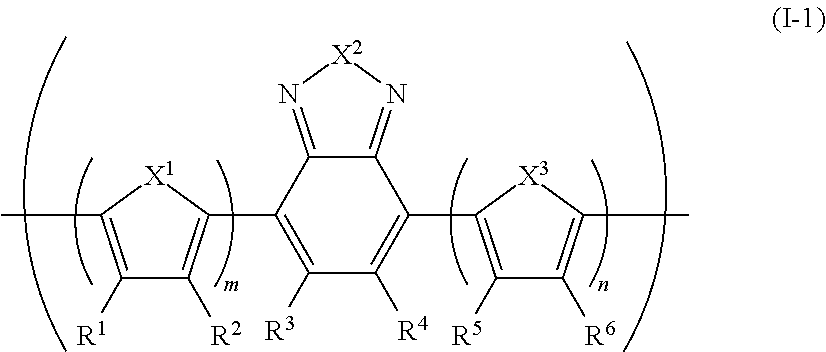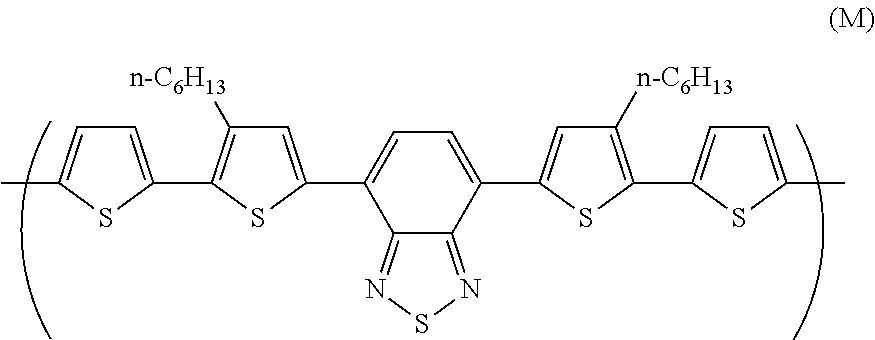Copolymer and polymer light emitting device using the same
a light-emitting device and polymer technology, applied in the direction of non-metal conductors, instruments, conductors, etc., can solve the problem of insufficient life of the light-emitting device of the polymer light-emitting devi
- Summary
- Abstract
- Description
- Claims
- Application Information
AI Technical Summary
Benefits of technology
Problems solved by technology
Method used
Image
Examples
examples
[0264]Examples and comparative examples will be shown below for illustrating the present invention further in detail, but the present invention is not limited to these examples.
[0265]The polystyrene-equivalent number average molecular weight and weight average molecular weight of a copolymer were measured by size exclusion chromatography (SEC) (manufactured by Shimadzu Corporation, trade name: LC-10 Avp). A copolymer to be measured was dissolved in tetrahydrofuran so as to give a concentration of about 0.5 wt %, and 50 μL of the solution was injected into SEC. Tetrahydrofuran was used as the mobile phase of SEC, and allowed to flow at a flow rate of 0.6 mL / min. As the column, two TSKgel Super HM-H (manufactured by Tosoh Corp.) and one TSKgel Super H2000 (manufactured by Tosoh Corp.) were connected serially. A differential refractive index detector (manufactured by Shimadzu Corp., trade name: RID-10A) was used as a detector.
example 1
Synthesis of Copolymer
(Synthesis of Pentamer 1)
[0266]A pentamer 1 was synthesized by a method described in Japanese Patent Application National Publication (Laid-Open) No. 2004-534863.
[0267]4,7-bis(5-bromo-4-hexylthien-2-yl)-2,1,3-benzothiadiazole and 2-(tributylstannyl)thiophene were dissolved in toluene, and reacted for 18 hours while refluxing with heating in the presence of tetrakis(triphenylphosphine)palladium. The resultant reaction product was cooled down to room temperature, and filtrated through silica gel. The filtrate was concentrated and re-crystallized from hexane.
[0268]The re-crystallized intermediate was dissolved in DMF, further, a DMF solution of N-bromosuccinimide was dropped, and the mixture was stirred overnight at room temperature. The product was filtrated, and washed with methanol and deionized water. The washed product was re-crystallized from hexane, to obtain a pentamer 1.
(Synthesis of 4,7-bis(5-bromo-4-methylthiophen-2-yl)-2,1,3-benzothiadiazole)
[0269]4,7...
synthesis example 1
Synthesis of Copolymer
[0274]Under an inert atmosphere, 2,7-bis(1,3,2-dioxaborolan-2-yl)-9,9-dihexylfluorene (0.72 g), 4,7-dibromo-2,1,3-benzothiadiazole (0.33 g), 4,7-bis(5-bromo-4-methylthiophen-2-yl)-2,1,3-benzothiadiazole (0.18 g), 4,7-bis(5-bromothiophen-2-yl)-2,1,3-benzothiadiazole (0.08 g), dichlorobis(triphenylphosphine)palladium (3.5 mg), methyltrioctyl ammonium chloride (trade name: Aliquat (registered trademark) 336, manufactured by Aldrich) (0.22 g) and toluene (17 mL) were mixed, and heated at 105° C. Into the resultant the reaction solution was dropped a 2 M sodium carbonate aqueous solution (5 mL), and the mixture was refluxed for 2 hours, to obtain a compound having a block (A). The block (A) had a polystyrene-equivalent number average molecular weight of 3.7×103 and a polystyrene-equivalent weight average molecular weight of 1.8×104. The degree of polymerization of the block (A) was about 14, estimated from this polystyrene-equivalent number average molecular weight...
PUM
| Property | Measurement | Unit |
|---|---|---|
| Electrical conductivity | aaaaa | aaaaa |
| Composition | aaaaa | aaaaa |
| Molecular weight | aaaaa | aaaaa |
Abstract
Description
Claims
Application Information
 Login to View More
Login to View More - R&D
- Intellectual Property
- Life Sciences
- Materials
- Tech Scout
- Unparalleled Data Quality
- Higher Quality Content
- 60% Fewer Hallucinations
Browse by: Latest US Patents, China's latest patents, Technical Efficacy Thesaurus, Application Domain, Technology Topic, Popular Technical Reports.
© 2025 PatSnap. All rights reserved.Legal|Privacy policy|Modern Slavery Act Transparency Statement|Sitemap|About US| Contact US: help@patsnap.com



